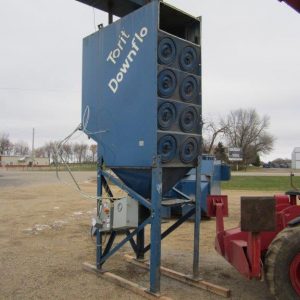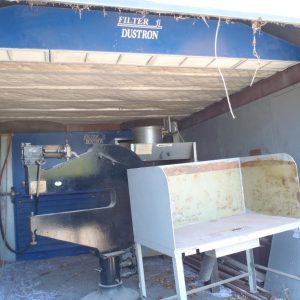We’ve compiled a list of common dust collection terms and phrases that many people have questions about.
A
Abrasion, Flex
Cloth wear in a creased area caused by excessive bending, usually associated with cage contact.
Abrasion, surface
More or less uniform wear on the dirty side of the cloth.
Acrylic
A synthetic polymerized fiber that contains at least 85% acrylonitrile.
Air Horsepower
The theoretical horsepower required to drive a fan if there were no losses in the fan, that is, it its efficiency were 100%
Air, Standard
Dry air at 70 F and 29.92 in (Hg) barometer. This is substantially equivalent to 0.075 lb./cu ft. Specific heat of dry air = 0.24 BTU/lb./F.
Air-to-cloth ratio
The amount of air or process gas entering the baghouse divided by the square foot of cloth in the baghouse
Aspect Ration
The ratio of the width to the length. AR = W/L
Aspect Ration, of Elbow
The width (W) along the axis of the bend divided by depth (D) in plane of bend. AR = W/D
B
Blast Gate
A sliding damper commonly found in the duct work attached to a dust or particle collection system.
Bleed through (see also “Leak through”)
Particles of dust or fumes that are able to migrate through the bag. (see leak through)
Binding
A closing of the filter medium pores which results in either a reduced gas flow or an increased pressure drop across the medium. If the medium cannot be cleaned readily and the pores reopened, this condition is often referred to as “permanent blinding” or plugging”.
Brake Horsepower
The horsepower actually required to drive a fan. This includes the energy losses in the fan and can be determined only by actual test of the fan. (This does not include the drive losses between motor and fan).
Bridge
Material blockage across an opening such as a hopper outlet or between bags.
C
Cake
The dust formation developed on the surface of the filter medium during the filtration process.
Can Velocity
The theoretical speed of dust laden air as it passes upward between the filter bags. The formula for calculating can velocity is as follows: The square area of the bag house (length x width) minus the area occupied by the bottom of the bags (the sum of the areas of the number of bags) divided into the volume of air in ACFM. This formula yields a velocity in fpm.
Can Velocity = ACFM / area of the tube sheet – (# of bags x area of the bottom of the bag)
Example: 100-10-AS Bag house, 8000 ACFM, Tube sheet I.D. = 7.75′ x 7.75′, 100 bags 6″ tube sheet holes, 5-7/8″ diameter bag bottom, Formula for the area of a circle = pi r2 Can Velocity = 8000 ACFM / 7.75′ x 7.75′ – (100 bags x (2.9375 x 2.9375 x 3.1416 / 144))
= 8000 ACFM / 60.0625 sq. ft. – (100 bags x(0.188254 sq. ft.))
= 8000 ACFM / 60.0625 sq. ft. – (18.8254)
= 8000 ACFM / 41.2371 sq. ft.
= 194.0 fpm can velocity
Capture Velocity
The air velocity at any point in front of the hood or at the hood opening necessary to overcome opposing air currents and to capture the contaminated air at that point by causing it to flow into the hood.
CFM
Acronym for Cubic Feet per Minute. CFM is often used to measure air volume velocity, and is a unit of measure used across a broad spectrum of industries including, but not limited to; commercial and residential HVAC, etc.
Cloth Weight
Usually expressed in oz./sq. yard.
Coating
Immersing the filter medium in a solution to provide the fibers with a coating that will lubricate and thereby reduce self-abrasion; in the case of woven-glass bags, the most common coatings have been Teflon and Silicone graphite.
Cold Spot
On an insulated bag house, a point where a continuous metallic heat transfer circuit through the insulation creates an un insulated area.
Concentration
Amount of dust in the gas. Usually expressed in terms of grains/cu ft., pounds/hour.
D
Density
The ratio of the mass of a specimen of a substance to the volume of the specimen. The mass of a unit volume of a substance. When weight can be used without confusion, as synonymous with mass, density is the weight of a unit volume of a substance.
Density Factor
The ratio of actual air density to density of standard air. The product of the density factor and the density of standard air (0.075 lb./cu ft.) will give the actual air density in lbs. per cu ft. d x 0.075 = actual density of air, lbs. per cubic ft.
Diaphragm Valve
A compressed air operated valve that is used to pulse bags.
Dust
Small solid particles created by the breaking up of larger particles by processes such as crushing, grinding, drilling, explosions, etc. Dust particles already in existence in a mixture of materials may escape into the air through such operations as shoveling, conveying, screening, sweeping, etc.
An air cleaning device to remove heavy particulate loadings from exhaust systems before discharge to outdoors. Usual range: Loadings 0.003 grains per cubic foot and higher.
Dust Loading
The quantity of dust in the gas stream, usually expressed as grains of dust per cubic foot of air.
E
Entry Loss
Loss in pressure caused by air flowing into a duct or hood (inches H20).
F
Fabric
A collective term applied to cloth no matter how constructed and regardless of the kind of fiber used. In the commonest sense, it refers to a woven cloth.
Felt
Fabric structures constructed by the interlocking action of the fibers themselves, without spinning, weaving, or knitting.
Felted Bag
Type of bag frequently used on pulse-jet dust collectors. Features a thick mat of fibers supported by woven backing or scrim.
Filter Cake
The accumulation of dust on a bag. Often assists in the filtration process. Also see cake. Filter Media: The permeable barrier employed in the filtration process to separate the particles from the fluid stream.
Filtration
A process by which particles are separated from a fluid stream by use of a permeable barrier.
Flange-to-Flange
The bag house equipment from inlet flange to outlet flange. Fumes: Small solid particles formed by the condensation of vapors of solid materials.
G
Gases
Formless fluids which tend to occupy an entire space uniformly at ordinary temperatures and pressures.
Glazing
High-pressure pressing of the filter medium at elevated temperatures; fuses surface fibers to the body of the filter medium.
Grain
A dust-weight unit commonly used in air pollution control. Equal to 1/7000 lb.
Grain Loading
Grains of dust per CFM.
Gravity, Specific
The ratio of the mass of a unit volume of a substance to the mass of the same volume of a standard substance at a standard temperature. Water at 39.2 F is the standard substance usually referred to. For gases, dry air, at the same temperature and pressure as the gas, is often taken as the standard substance.
H
Header
A pressurized pipe that contains the compressed air supply for a pulse type bag house.
Hood
A shaped inlet designed to capture contaminated air and conduct it into the exhaust dust system. Humidity, Absolute: The weight of water vapor per unit volume, pounds per cubic foot or grams per cubic centimeter.
Humidity, Relative
The ratio of the actual partial pressure of the water vapor in a space to the saturation pressure of pure water at the same temperature.
Hydrophobic Fibers
Fibers that do not readily absorb water.
Hydrophilic Fibers
Fibers that readily absorb water
I
Inch of Water
A unit of pressure equal to the pressure exerted by a column of liquid water an inch high at a standard temperature.
Interstices
Openings between the fibers in a woven or felted filter bag.
L
Leak through
Dust or fume that leaks through a bad bag seal or a hole or crack in the tube sheet.
M
Manometer
An instrument for measuring pressure; essentially a U-tube partially filled with a liquid, usually water, mercury or a light oil, so constructed that the amount of displacement of the liquid indicates the pressure being exerted on the instrument.
Micron
A unit of length, the thousandth part of I mm or the millionth of a meter (approximately 1/25,000 of an inch). Minimum Design Duct Velocity: Minimum air velocity required to move the particulates in the air stream, fpm.
Mists
Small droplets of materials that are ordinarily liquid at normal temperature and pressure.
N
Needled Felt
A felt constructed by the use of barbed needles moving up and down, pushing and pulling the fibers to form an interlocking of adjacent fibers.
P
Permeability
A measure of fabric porosity or openness, usually expressed in cfm at a 0.5″ H20 pressure differential.
Plenum
Pressure equalizing chamber.
Porosity
Sometimes erroneously used as a synonym for permeability. Originally a designation for the amount of air in a fabric, i.e., blankets.
Pre-coat
Material added to air stream on initial process startup to aid in establishing filter cake on bags.
Pressure Drop
Resistance to air flow; may refer to pressure differential across the cloth, across the bag house or the pressure drop across the entire system.
Pressure, Static
The potential pressure exerted in all directions by a fluid at rest. For a fluid in motion it is measured in a direction normal to the direction of flow. Usually expressed in inches water gauge when dealing with air. (The tendency to either burst or collapse the pipe).
Pressure, Total
The algebraic sum of the velocity pressure and the static pressure (with due regard to sign). Pressure, Velocity: The kinetic pressure in the direction of flow necessary to cause a fluid at rest to flow at a given velocity. Usually expressed in inches water gauge.
Pulse Cycle
The interval of time between one pulsing of a row of bags and the next pulsing of the same row.
Pulse Interval
Time between pulsing one row of bags and pulsing the next row.
Generic name given to all pulsing collectors.
R
Radiation, Thermal Radiation
The transmission of energy by means of electromagnetic waves of very long wave length. Radiant energy of any wave length may, when absorbed, becomes thermal energy and results in an increase in the temperature of the absorbing body.
Re-entrainment
The re-depositing of dust on the filter bag surface after it has been pulsed off. Re-entrainment is usually caused by turbulence in the hopper or dirty air plenum.
Replacement Air
A ventilation term used to indicate the volume of controlled outdoor air supplied to a building to replace air being exhausted.
A unit employing reverse flow flushing air to clean the dust from the bags.
S
Scrim
A very loosely woven fabric onto which felt is needled.
Seeding
The application of a relatively coarse, dry dust to a bag before startup to provide an initial filter cake for immediate high efficiency and to protect bags from blinding. (see Pre-coat) Shaker Bag house: A unit wherein cleaning is accomplished by shaking the bags.
Singeing
Passing of the filter medium over an open flame, thereby removing the protruding surface fibers. Slot Velocity: Linear flow rate of contaminated air through cloth, fpm.
Smoke
An air suspension (aerosol) of particles, usually but not necessarily solid, often originating in a solid nucleus, formed from combustion or sublimation.
T
Temperature, Effective
An arbitrary index which combines into a single value the effect of temperature, humidity and air movement on the sensation of warmth or cold felt by the human body. The numerical value is that of the temperature of still, saturated air which would induce an identical sensation.
Temperature, Wet-Bulb
Thermodynamic wet-bulb temperature is the temperature at which liquid or solid water, by evaporating into air, can bring the air to saturation adiabatically at the same temperature. Wet-bulb temperature (without qualification) is the temperature indicated by a wet-bulb psychrometer constructed and used according to specifications.
Transport-Conveying Velocity
See Minimum Design Duct Velocity.
Tube Sheet
The steel plate that bags are suspended from in a bag house.
Turn Key
Complete bag house System including all dust pickups, ducting, dust discharge auxiliaries and all equipment which is part of the dust collection system.
V
Vapor
The gaseous form of substances which are normally in the solids or liquid state and which can be changed to these states either by increasing the pressure or decreasing the temperature. Vapors diffuse.






